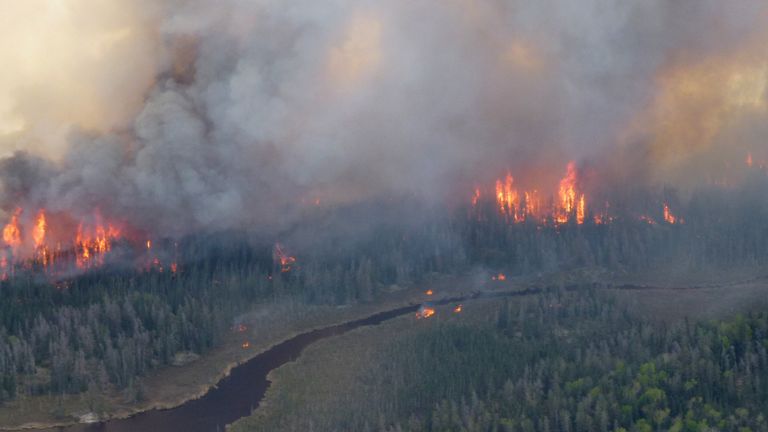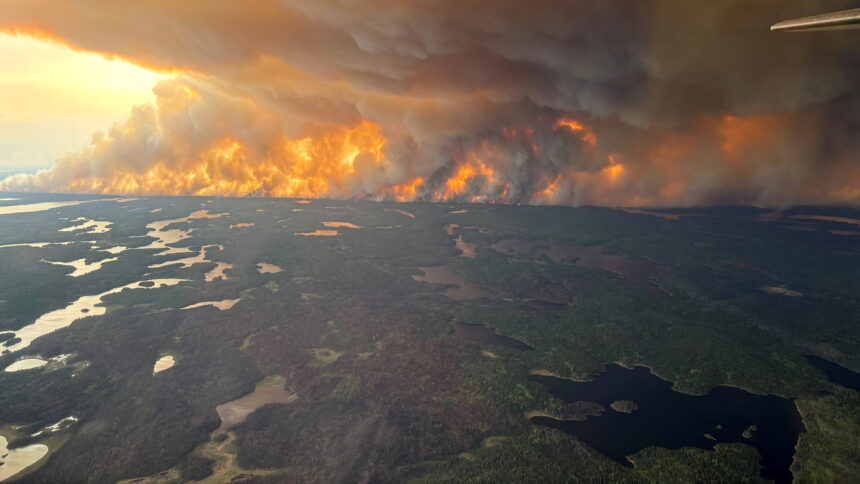Wildfire Emergency Grips Western Canada
Canada is facing a devastating wildfire crisis once again. Over 17,000 people have been forced to evacuate in Manitoba alone as fast-moving wildfires sweep through the provinces of Manitoba, Saskatchewan, and parts of Alberta and British Columbia. The fires have triggered a state of emergency and widespread evacuations, especially in northern First Nations communities.
Fire Statistics and Air Quality Concerns

According to the Canadian Interagency Forest Fire Centre (CIFFC), more than 188 wildfires are active across Canada. In Manitoba, 25 fires are burning, with 11 declared out of control. In Saskatchewan, 17 fires are active, eight of which are uncontained.
Smoke from these fires has blanketed large parts of Canada and spilled into the United States, affecting air quality for more than 22 million Americans. The state of Minnesota is under an air quality alert, with some areas experiencing conditions deemed “unhealthy for everyone.”
Evacuations and Emergency Response
The community of Pukatawagan in northern Manitoba faces a “rapidly evolving situation,” with the Canadian Armed Forces using military aircraft and helicopters to evacuate residents. In Flin Flon, a town of 5,000, only firefighters and emergency crews remain. Prime Minister Mark Carney praised the coordination of evacuation teams, calling their work “unwavering.”
Saskatchewan Premier Scott Moe warned the number of evacuees could rise to 10,000 as the fires spread. “The next four to seven days are absolutely critical,” he said, referring to the need for rainfall and cooler temperatures.
Climate and Weather Conditions
Weather forecasts show little relief. While a cold front may touch parts of Saskatchewan, it brings strong winds—a dangerous mix with dry vegetation. Meteorologist Danielle Desjardins noted that this combination increases the likelihood of fire spread.

These extreme weather patterns are increasingly linked to climate change. The UN’s climate panel has warned that prolonged heat and reduced moisture create ideal wildfire conditions. This follows Canada’s worst fire season on record in 2023, when 42 million acres burned.
How Climate Change Fuels Wildfires
Fires are a natural part of many ecosystems, but scientists say human-driven climate change is making them more intense and frequent. Rising global temperatures are causing:
- Longer dry seasons
- Increased lightning strikes
- Hotter summers with less rainfall
As wildfires grow in scale and speed, communities are often left with just hours to evacuate—especially in remote areas where roads are limited and airlifts are the only option.
Conclusion: A Call for Global Attention
The current Canadian wildfire emergency is not just a national crisis—it’s a global climate warning. With weather conditions worsening and evacuation resources stretched thin, Canada is calling for international aid. The wildfire smoke now impacting the U.S. is a reminder that these events have no borders.
For related coverage, check out: 2023 Canada Wildfire Season: Record Destruction.
Stay informed and stay safe. Subscribe for real-time updates on natural disasters, environmental policies, and climate science.









